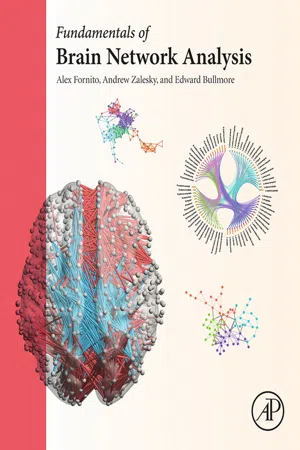
- 494 pages
- English
- ePUB (mobile friendly)
- Available on iOS & Android
Fundamentals of Brain Network Analysis
About This Book
Fundamentals of Brain Network Analysis is a comprehensive and accessible introduction to methods for unraveling the extraordinary complexity of neuronal connectivity. From the perspective of graph theory and network science, this book introduces, motivates and explains techniques for modeling brain networks as graphs of nodes connected by edges, and covers a diverse array of measures for quantifying their topological and spatial organization. It builds intuition for key concepts and methods by illustrating how they can be practically applied in diverse areas of neuroscience, ranging from the analysis of synaptic networks in the nematode worm to the characterization of large-scale human brain networks constructed with magnetic resonance imaging. This text is ideally suited to neuroscientists wanting to develop expertise in the rapidly developing field of neural connectomics, and to physical and computational scientists wanting to understand how these quantitative methods can be used to understand brain organization.
- Winner of the 2017 PROSE Award in Biomedicine & Neuroscience and the 2017 British Medical Association (BMA) Award in Neurology
- Extensively illustrated throughout by graphical representations of key mathematical concepts and their practical applications to analyses of nervous systems
- Comprehensively covers graph theoretical analyses of structural and functional brain networks, from microscopic to macroscopic scales, using examples based on a wide variety of experimental methods in neuroscience
- Designed to inform and empower scientists at all levels of experience, and from any specialist background, wanting to use modern methods of network science to understand the organization of the brain
Frequently asked questions
Information
Table of contents
- Cover image
- Title page
- Table of Contents
- Copyright
- Author Biographies
- Foreword
- Acknowledgments
- Chapter 1: An Introduction to Brain Networks
- Chapter 2: Nodes and Edges
- Chapter 3: Connectivity Matrices and Brain Graphs
- Chapter 4: Node Degree and Strength
- Chapter 5: Centrality and Hubs
- Chapter 6: Components, Cores, and Clubs
- Chapter 7: Paths, Diffusion, and Navigation
- Chapter 8: Motifs, Small Worlds, and Network Economy
- Chapter 9: Modularity
- Chapter 10: Null Models
- Chapter 11: Statistical Connectomics
- Glossary
- References
- Index